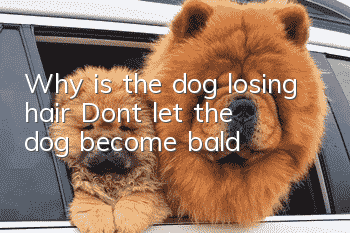Why is the dog losing hair? Don’t let the dog become “bald”

Causes of hair loss in dogs
Alopecia is divided into two types: congenital and acquired.1. Congenital nature is found in heredity.
2. Acquired alopecia is often secondary to systemic diseases such as neurological diseases, endocrine diseases (thyroid and pituitary disorders, testicular and ovarian dysfunction), febrile diseases (pneumonia or infectious diseases, etc.), and nutritional disorders , toxic diseases and some malignant diseases.
3. External stimulation can also cause alopecia.
Symptoms of hair loss in dogs
1. Congenital hair loss: When a dog is born, it is occasionally seen that there is no hair on the forehead, top of the head, lower abdomen, thighs, etc. This phenomenon is more common in poodles. Black and white mixed dogs gradually lose hair on their black hair at 4 weeks of age. These are all hereditary hair loss. The genetic mutation occurs in blue or red Dobermans, blue dachshunds, and Wilbur setters, which are born with normal coats but soon begin to lose their hair.2. Acquired hair loss: Hair loss often starts locally, and then merges with lesions in adjacent areas. The bald area gradually expands, accompanied by flakes. Neurogenic and endocrine alopecia, skin lesions occur symmetrically on the inner thigh. By about 1 year old, except for the head and limbs, other parts of the body will be hairless to varying degrees, with pigmentation and a large amount of scales, sometimes with the appearance of red papules. shape.
3. Pituitary hormone disorders lead to gonadal hypofunction. This disease is more common in shepherd dogs.
4. Ovarian insufficiency can easily lead to obvious pigmentation and thickening of the skin around the pubic area, groin, and chest, which can easily induce seborrheic dermatitis, leading to hair loss in dogs.
5. Toxic alopecia: mainly caused by mercury, thallium and other poisonings. When the central nervous system is poisoned, erythematous dermatitis occurs in many parts of the skin, causing hair loss, scabs, ulcers, and symptoms of digestive tract and kidney poisoning.
6. Dystrophic hair loss: body weight loss, dull coat, skin loss of elasticity, etc.
Prevention and treatment measures for dog hair loss
1. Correctly identify the cause of the disease, treat the primary disease, and treat the symptoms at the same time. Remove scales from the hair removal area, stimulate hair roots and expand skin capillaries, so that hair follicles The principle is to provide adequate nutrition and promote coat regeneration.2. You can use 1% pilocarpine ointment, 40% lecithin ointment, and 1% acetylcholine chloride ointment. Apply it every day and massage gently. You can also mix 18g of salicylic acid, 18g of tannic acid and 600ml of ethanol and apply it to the affected area.
3. For endocrine alopecia, use hormonal therapy, prednisone 2 mg/kg body weight subcutaneous injection, administration of male hormones or sterilization surgery. For those with ovarian insufficiency, the ovaries and uterus can be removed.
4. In addition to targeted treatment for toxic hair removal, cystine and methionine can be administered. For hair loss caused by hypothyroidism, thyroid preparations can be taken orally, 2 tablets a day, gradually increasing to 6-10 tablets.
5. For other dogs with unexplained hair loss, apply hair regeneration stimulator locally.
6. PetsThe dog's living environment should be kept dry, disinfected regularly, and pathogenic microorganisms should be killed. If necessary, the pet dog should be equipped with an insect-proof collar.
7. Comprehensively strengthen the dog’s nutrition and provide sufficient protein, vitamins and trace elements to improve the dog’s resistance. If hair loss is discovered, timely diagnosis and treatment is required.
Random articles
- What do dogs eat to protect their stomach? It is important to protect their stomach and treat gastrointestinal diseases in dogs.
- How to tell if your dog is fat? Is your dog overweight?
- Will your dog catch a cold if you blow the air conditioner? What should you do if your dog catches a cold if you blow the air conditioner?
- What should you pay attention to when your dog drinks water? Don’t be careless when it comes to your dog’s drinking water.
- The dog's mouth bites and shakes. Why does the dog's mouth occasionally shake and bite?
- How to cut a dog's hair? Do you know how to cut a dog's hair correctly?
- Can dogs eat raw eggs? Why can’t dogs eat egg whites?
- Common Dog Problems in Summer How to Deal with Different Dog Problems
- How to keep dogs away from skin diseases. If you do this, will you see if your dog will still be infected with skin diseases?
- What causes anorexia in dogs? Dogs will become anorexic due to lack of exercise. Hounds run at least 5KM every day.



